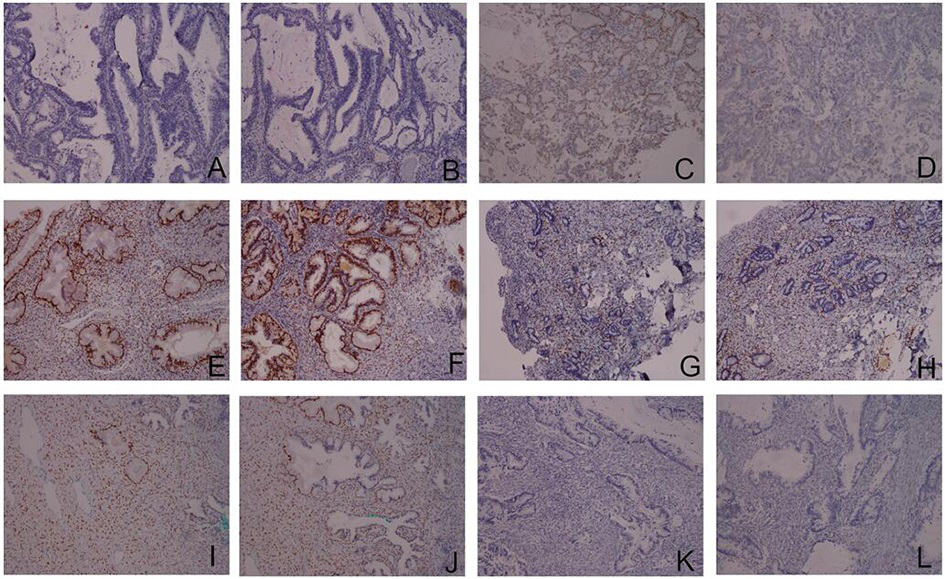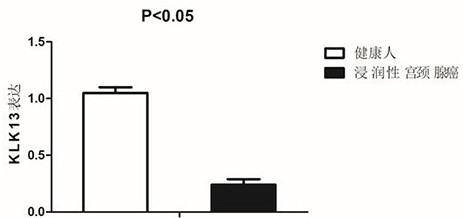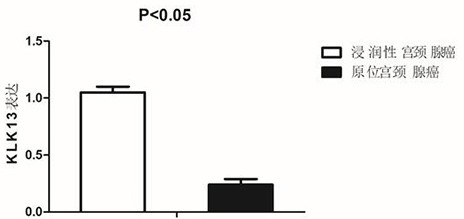Application of klk13 in the preparation of a detection kit for diagnosing cervical adenocarcinoma
A detection kit and technology for cervical adenocarcinoma, applied in the field of immune detection, can solve the problem of not finding the specificity of KLK13 expression, and achieve the effect of high sensitivity and specificity, high application prospect, and help in diagnosis
- Summary
- Abstract
- Description
- Claims
- Application Information
AI Technical Summary
Problems solved by technology
Method used
Image
Examples
Embodiment 1
[0016] Example 1 Effect of Biopsy and Cervical Mucus Samples on EP and PR
[0017] This experiment adopts the EnVision System two-step method: the EnVision chromogenic system connects the secondary antibody and the enzyme into a polymer through a polydextran backbone to directly amplify the signal 40 to 50 times, and the traditional secondary antibody and tertiary antibody are respectively Incubation was combined into one incubation. The cervical tissues of the subjects were fixed with 4% paraformaldehyde fixative solution, dehydrated, transparentized, soaked in wax, and sectioned, followed by two-step immunohistochemical staining, and then used a microscope for diagnosis and image collection. As shown in Table 1, using traditional cervical adenocarcinoma biopsy markers and immunohistochemical detection methods to analyze ER and PR, it can be seen that the specificity and sensitivity of the two for cervical tissue detection are very low. figure 1 The immunohistochemical photo...
Embodiment 2
[0021] Example 2 iTRAQ quantitative analysis test
[0022] 1. Sample Processing and Protein Extraction
[0023] The cervical mucus samples of 9 subjects were extracted by scraping with cotton swabs, among which 3 were normal subjects, 3 were patients with cervical adenocarcinoma in situ, and 3 were patients with invasive cervical adenocarcinoma.
[0024] Add protein lysate (7M Urea / 2M Thiourea / 4% SDS / 40 mM Tris-HCl, pH8.5 / 1mM PMSF / 2mM EDTA) to the sample, mix well and incubate on ice for 5 min, then add the final concentration of 10 mM DTT, sonicate in an ice bath for 15 min, then centrifuge at 13,000 g at 4 °C for 20 min, transfer the supernatant to a new centrifuge tube; Let stand overnight. The protein precipitate was collected by centrifugation and air dried. Add 8 Murea / 100 mM TEAB (pH 8.0) solution to redissolve the protein, add DTT to a final concentration of 10 mM, and carry out the reduction reaction in a water bath at 56 °C for 30 min. Subsequently, IAM was add...
Embodiment 3
[0035] Example 3 siRNA interference cell experiment
[0036] 1. Cell Scratch Test
[0037] The samples in this experiment were cervical tissue mucus from patients with cervical cancer, and the control group was cervical adenocarcinoma HeLa cells whose expression of KLK13 was not knocked down. First, cervical adenocarcinoma HeLa cells were seeded in 96-well plates and cultured in DMEM containing 10% fetal bovine serum (Gibco, USA) at 37°C, 5% CO 2 Routine culture in the incubator, when the degree of cell confluence reached 100%, the mixture of liposome and KLK13 siRNA (5'-UCAAAGUUUACCUAGGCAATT-3', synthesized by Shanghai Gemma Company) was prepared according to the instructions of Lipofectamine 2000 (Invitrogen, USA). HeLa cells were transiently transfected. After 6 h, the transfection reagent was discarded, and DMEM medium containing 10% fetal bovine serum was added to continue culturing for 48 h.
[0038] Scratch the bottom of the 96-well plate with the tip of a plastic ...
PUM
 Login to View More
Login to View More Abstract
Description
Claims
Application Information
 Login to View More
Login to View More - R&D
- Intellectual Property
- Life Sciences
- Materials
- Tech Scout
- Unparalleled Data Quality
- Higher Quality Content
- 60% Fewer Hallucinations
Browse by: Latest US Patents, China's latest patents, Technical Efficacy Thesaurus, Application Domain, Technology Topic, Popular Technical Reports.
© 2025 PatSnap. All rights reserved.Legal|Privacy policy|Modern Slavery Act Transparency Statement|Sitemap|About US| Contact US: help@patsnap.com



